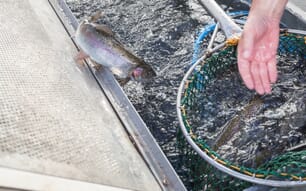Viral haemorrhagic septicaemia virus (VHSV) is a negative-sense, single-stranded RNA virus, which belongs to the Novirhabdovirus genus within the Rhabdoviridae family, write Dagoberto Sepúlveda and Niels Lorenzen, Department of Animal Science, Aarhus University, Aarhus, Denmark.
VHSV is the causative agent of the viral haemorrhagic septicaemia (VHS), a serious and economically important disease of farmed rainbow trout (Oncorhynchus mykiss) in Europe, causing high mortalities in all fish stages.
Currently, no commercial vaccine against VHS is available. Several vaccination strategies have been tested to control this disease, among them live attenuated vaccines, inactivated vaccines, and recombinant protein vaccines, but with limited efficacy or compromised safety aspects. By contrast, DNA vaccines have shown promising results by consistently protecting fish against VHS and related diseases. This led to the licensing and use of a DNA vaccine against infectious hematopoietic necrosis (IHN), caused by the related IHN virus, in Atlantic salmon in Canada since 2005, with no outbreaks reported since.
The traditional DNA vaccine against VHS consists of a plasmid designed for expression of the viral surface glycoprotein (G) in eukaryotic cells. The immune protection induced by this vaccine start as early as 4 days after intramuscular injection, when an early, non-specific, and short-lasting antiviral protection is triggered. This early protection has been related to interferon-associated mechanisms, which are characterized by the overexpression of multiples interferon-stimulated genes with antiviral functions such as Mx, Vig-1, Vig-2, and Vig-8 . After 4–6 weeks depending on the water temperature, the temporary early protection is followed by the late, specific and long-lasting immunity, which includes the induction of both arms of adaptive immunity: the cell-mediated and the humoral responses.
Although the high efficacy of the DNA vaccine against VHSV has been consistent under experimental conditions, its protective effect might be threatened following repeated use under field conditions, due to the high variability of RNA viruses. Whether this variability might allow generation and selection of VHSV mutants, capable of evading the immunological protection induced by the DNA vaccine remains to be addressed.
Evidence of how the genetic variability of VHSV allows adaptation to selective conditions was shown when rainbow trout were injected with a plasmid encoding a neutralizing single chain antibody (scAb) against the G protein of VHSV. In this case, a neutralization escape mutant was isolated from the survivors of the infection. Similarly, selective conditions provided by neutralizing monoclonal antibodies promoted the growth of neutralization-resistant virus variants in cell culture. Similar observations have been made for IHNV.
While mutations in the G protein can affect the efficacy of the adaptive protection, mutations in e.g. the non-structural-protein (NV) may potentially affect the ability of the virus to bypass the innate protection induced by the DNA vaccine. This viral protein has been suggested to inhibit the apoptotic signal in virus infected cells at an early stage of virus infection, thus affecting the virulence of the VHSV.
The aim of this work was to determine whether VHSV within repetitive passages under the selective pressure of DNA vaccine-induced immunity, would be able to develop mutants that could escape from the early and late protective mechanisms induced by the vaccine, and from neutralizing serum antibodies induced in DNA-vaccinated rainbow trout. Knowledge of these aspects is essential for the design of robust and safe DNA vaccination strategies for protection of rainbow trout against VHS under field conditions.



